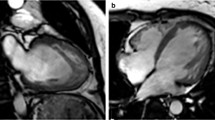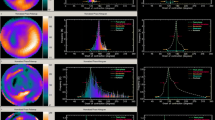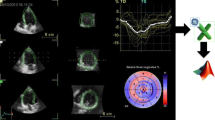Abstract
Cardiac resynchronization therapy (CRT) is theoretically expected to affect repolarization as well as depolarization. We studied the effects of CRT on corrected QT (QTc) dispersion in association with symptomatic improvement. QTc dispersion was analyzed in 26 consecutive patients (67 ± 6 years old, 18 men and 8 women) who underwent CRT. CRT responders and nonresponders were defined as patients showing and not showing ≥1 class New York Heart Association symptomatic improvement 3 months after CRT, respectively. QTc interval, QRS width, and QTc dispersion were measured automatically from digital data using an analyzing system. There were 18 CRT responders and 8 nonresponders among the patients. CRT responders showed significantly larger QTc dispersion than CRT nonresponders before CRT (102 ± 26 vs 40 ± 12 ms, P < 0.01). A significant decrease in QTc dispersion by CRT was observed in responders (102 ± 26 to 52 ± 15 ms, P < 0.01). In contrast, QTc dispersion was not decreased by CRT in nonresponders (40 ± 12 to 39 ± 11 ms, not significant). The difference observed before CRT was thus abolished after CRT (52 ± 15 vs 39 ± 11 ms, not significant). Baseline values and changes in QRS width or QTc, as well as asynchrony of wall motion determined by tissue Doppler imaging, were not different between CRT responders and nonresponders before CRT. The present study with a small number of patients shows the potential utility of QTc dispersion for distinguishing CRT responders from CRT nonresponders before CRT, and warrants further study with a greater number of patients.
Similar content being viewed by others
References
Yu CM, Fung WH, Lin H, Zhang Q, Sanderson JE, Lau CP (2003) Predictors of left ventricular reverse remodeling after cardiac resynchronization therapy for heart failure secondary to idiopathic dilated or ischemic cardiomyopathy. Am J Cardiol 91:684–688
St John Sutton MG, Plappert T, Abraham WT, Smith AL, DeLurgio DB, Leon AR, Loh E, Kocovic DZ, Fisher WG, Ellestad M, Messenger J, Kruger K, Hilpisch KE, Hill MR (2003) Effect of cardiac resynchronization therapy on left ventricular size and function in chronic heart failure. Circulation 107:1985–1990
Salukhe TV, Francis DP, Sutton R (2003) Comparison of medical therapy, pacing and defibrillation in heart failure (COMPANION) trial terminated early; combined biventricular pacemaker-defibrillators reduce all-cause mortality and hospitalization. Int J Cardiol 87:119–120
Bradley DJ, Bradley EA, Baughman KL, Berger RD, Calkins H, Goodman SN, Kass DA, Powe NR (2003) Cardiac resynchronization and death from progressive heart failure: a meta-analysis of randomized controlled trials. JAMA 289:730–740
Abraham WT, Fisher WG, Smith AL, Delurgio DB, Leon AR, Loh E, Kocovic DZ, Packer M, Clavell AL, Hayes DL, Ellestad M, Trupp RJ, Underwood J, Pickering F, Truex C, McAtee P, Messenger J (2002) Cardiac resynchronization in chronic heart failure. N Engl J Med 346:1845–1853
Pitzalis MV, Iacoviello M, Romito R, Massari F, Rizzon B, Luzzi G, Guida P, Andriani A, Mastropasqua F, Rizzon P (2002) Cardiac resynchronization therapy tailored by echocardiographic evaluation of ventricular asynchrony. J Am Coll Cardiol 40:1615–1622
Achilli A, Sassara M, Ficili S, Pontillo D, Achilli P, Alessi C, De Spirito S, Guerra R, Patruno N, Serra F (2003) Long-term effectiveness of cardiac resynchronization therapy in patients with refractory heart failure and “narrow” QRS. J Am Coll Cardiol 42:2117–212
Yu CM, Fung JW, Chan CK, Chan YS, Zhang Q, Lin H, Yip GW, Kum LC, Kong SL, Zhang Y, Sanderson JE (2004) Comparison of efficacy of reverse remodeling and clinical improvement for relatively narrow and wide QRS complexes after cardiac resynchronization therapy for heart failure. J Cardiovasc Electrophysiol 15:1058–1065
Bax JJ, Marwick TH, Molhoek SG, Bleeker GB, van Erven L, Boersma E, Steendijk P, van der Wall EE, Schalij MJ (2003) Left ventricular dyssynchrony predicts benefit of cardiac resynchronization therapy in patients with end-stage heart failure before pacemaker implantation. Am J Cardiol 92:1238–1240
Yu CM, Fung JW, Zhang Q, Chan CK, Chan YS, Lin H, Kum LC, Kong SL, Zhang Y, Sanderson JE (2004) Tissue Doppler imaging is superior to strain rate imaging and postsystolic shortening on the prediction of reverse remodeling in both ischemic and nonischemic heart failure after cardiac resynchronization therapy. Circulation 110:66–73
Penicka M, Bartunek J, De Bruyne B, Vanderheyden M, Goethals M, De Zutter M, Brugada P, Geelen P (2004) Improvement of left ventricular function after cardiac resynchronization therapy is predicted by tissue Doppler imaging echocardiography. Circulation 109:978–983
Notabartolo D, Merlino JD, Smith AL, DeLurgio DB, Vera FV, Easley KA, Martin RP, Leon AR (2004) Usefulness of the peak velocity difference by tissue Doppler imaging technique as an effective predictor of response to cardiac resynchronization therapy. Am J Cardiol 94:817–820
Gorcsan J, 3rd, Kanzaki H, Bazaz R, Dohi K, Schwartzman D (2004) Usefulness of echocardiographic tissue synchronization imaging to predict acute response to cardiac resynchronization therapy. Am J Cardiol 93:1178–1181
Yu CM, Zhang Q, Fung JW, Chan HC, Chan YS, Yip GW, Kong SL, Lin H, Zhang Y, Sanderson JE (2005) A novel tool to assess systolic asynchrony and identify responders of cardiac resynchronization therapy by tissue synchronization imaging. J Am Coll Cardiol 45:677–684
Sogaard P, Egeblad H, Kim WY, Jensen HK, Pedersen AK, Kristensen BO, Mortensen PT (2002) Tissue Doppler imaging predicts improved systolic performance and reversed left ventricular remodeling during long-term cardiac resynchronization therapy. J Am Coll Cardiol 40:723–730
Kountouris E, Pappa E, Korantzopoulos P, Pappas K, Karanikis P, Dimitroula V, Ntatsis A, Siogas K (2004) Usefulness of predischarge exercise electrocardiographic testing in detecting the late patency status of the infarct-related artery. Heart Vessels 19: 111–115
Medina-Ravell VA, Lankipalli RS, Yan GX, Antzelevitch C, Medina-Malpica NA, Medina-Malpica OA, Droogan C, Kowey PR (2003) Effect of epicardial or biventricular pacing to prolong QT interval and increase transmural dispersion of repolarization: does resynchronization therapy pose a risk for patients predisposed to long QT or torsade de pointes? Circulation 107: 740–746
Berger T, Hanser F, Hintringer F, Poelzl G, Fischer G, Modre R, Tilg B, Pachinger O, Roithinger FX (2005) Effects of cardiac resynchronization therapy on ventricular repolarization in patients with congestive heart failure. J Cardiovasc Electrophysiol 16:611–617
Szymanski P, Swiatkowski M, Rezler J, Budaj A (1999) The relationship between diastolic function of the left ventricle and QT dispersion in patients with myocardial infarction. Int J Cardiol 69:245–249
Cowan JC, Yusoff K, Moore M, Amos PA, Gold AE, Bourke JP, Tansuphaswadikul S, Campbell RW (1988) Importance of lead selection in QT interval measurement. Am J Cardiol 61:83–87
World Medical Association (1997) Declaration of Helsinki. Recommendations guiding physicians in biomedical research involving human subjects. Cardiovasc Res 35:2–3
Prabhu SD (2007) Altered left ventricular-arterial coupling precedes pump dysfunction in early heart failure. Heart Vessels 22:170–177
Kindermann M, Frohlig G, Doerr T, Schieffer H (1997) Optimizing the AV delay in DDD pacemaker patients with high degree AV block: mitral valve Doppler versus impedance cardiography. Pacing Clin Electrophysiol 20:2453–2462
Ritter P, Daubert C, Mabo P, Descaves C, Gouffault J (1989) Haemodynamic benefit of a rate-adapted A-V delay in dual chamber pacing. Eur Heart J 10:637–646
Figueredo EJ, Ohnishi Y, Yoshida A, Yokoyama M (2001) Usefulness of beat-to-beat QT dispersion fluctuation for identifying patients with coronary heart disease at risk for ventricular arrhythmias. Am J Cardiol 88:1235–1239
Bazett HC (1920) An analysis of the time-relations of electrocardiograms. Heart 7:353–370
Sakabe K, Ikeda T, Sakata T, Kawase A, Kumagai K, Tezuka N, Takami M, Nakae T, Noro M, Enjoji Y, Sugi K, Yamaguchi T (2001) Comparison of T-wave alternans and QT interval dispersion to predict ventricular tachyarrhythmia in patients with dilated cardiomyopathy and without antiarrhythmic drugs: a prospective study. Jpn Heart J 42:451–457
Yu CM, Chau E, Sanderson JE, Fan K, Tang MO, Fung WH, Lin H, Kong SL, Lam YM, Hill MR, Lau CP (2002) Tissue Doppler echocardiographic evidence of reverse remodeling and improved synchronicity by simultaneously delaying regional contraction after biventricular pacing therapy in heart failure. Circulation 105:438–445
Terzi S, Sayar N, Bilsel T, Enc Y, Yildirim A, Ciloglu F, Yesilcimen K (2007) Tissue Doppler imaging adds incremental value in predicting exercise capacity in patients with congestive heart failure. Heart Vessels 22:237–244
Bank AJ, Kelly AS (2006) Tissue Doppler imaging and left ventricular dyssynchrony in heart failure. J Card Fail 12:154–162
Cho GY, Song JK, Park WJ, Han SW, Choi SH, Doo YC, Oh DJ, Lee Y (2005) Mechanical dyssynchrony assessed by tissue Doppler imaging is a powerful predictor of mortality in congestive heart failure with normal QRS duration. J Am Coll Cardiol 46: 2237–2243
Sakabe K, Fukuda N, Fukuda Y, Wakayama K, Nada T, Morishita S, Shinohara H, Tamura Y (2008) QT-interval dispersion in type 2 diabetic and non-diabetic patients with post-myocardial infarction. Nutr Metab Cardiovasc Dis 18:121–126
Spargias KS, Lindsay SJ, Kawar GI, Greenwood DC, Cowan JC, Ball SG, Hall AS (1999) QT dispersion as a predictor of long-term mortality in patients with acute myocardial infarction and clinical evidence of heart failure. Eur Heart J 20:1158–1165
Anastasiou-Nana MI, Nanas JN, Karagounis LA, Tsagalou EP, Alexopoulos GE, Toumanidis S, Gerali S, Stamatelopoulos SF, Moulopoulos SD (2000) Relation of dispersion of QRS and QT in patients with advanced congestive heart failure to cardiac and sudden death mortality. Am J Cardiol 85:1212–1217
Brendorp B, Elming H, Jun L, Kober L, Malik M, Jensen GB, Torp-Pedersen C (2001) QT dispersion has no prognostic information for patients with advanced congestive heart failure and reduced left ventricular systolic function. Circulation 103:831–835
Gang Y, Ono T, Hnatkova K, Hashimoto K, Camm AJ, Pitt B, Poole-Wilson PA, Malik M (2003) QT dispersion has no prognostic value in patients with symptomatic heart failure: an ELITE II substudy. Pacing Clin Electrophysiol 26:394–400
Fei L, Goldman JH, Prasad K, Keeling PJ, Reardon K, Camm AJ, McKenna WJ (1996) QT dispersion and RR variations on 12-lead ECGs in patients with congestive heart failure secondary to idiopathic dilated cardiomyopathy. Eur Heart J 17:258–263
Harjai KJ, Samal A, Shah M, Edupuganti R, Nunez E, Pandian NG (2002) The relationship between left ventricular shape and QT interval dispersion. Echocardiography 19:641–644
Gunduz H, Akdemir R, Binak E, Tamer A, Uyan C (2003) Relation between stage of left ventricular diastolic dysfunction and QT dispersion. Acta Cardiol 58:303–308
Bugra Z, Koylan N, Vural A, Erzengin F, Umman B, Yilmaz E, Meric M, Buyukozturk K (1998) Left ventricular geometric patterns and QT dispersion in untreated essential hypertension. Am J Hypertens 11:1164–1170
Henein M (1999) The relationship between diastolic function of the left ventricle and QT dispersion in patients with myocardial infarction. Int J Cardiol 71:195
Chapman N, Mayet J, Ozkor M, Lampe FC, Thom SA, Poulter NR (2001) QT intervals and QT dispersion as measures of left ventricular hypertrophy in an unselected hypertensive population. Am J Hypertens 14:455–462
Coumel P, Maison-Blanche P, Badilini F (1998) Dispersion of ventricular repolarization: reality? Illusion? Signifi cance? Circulation 97:2491–2493
Barr CS, Naas A, Freeman M, Lang CC, Struthers AD (1994) QT dispersion and sudden unexpected death in chronic heart failure. Lancet 343:327–329
Pinsky DJ, Sciacca RR, Steinberg JS (1997) QT dispersion as a marker of risk in patients awaiting heart transplantation. J Am Coll Cardiol 29:1576–1584
Author information
Authors and Affiliations
Corresponding author
Rights and permissions
About this article
Cite this article
Hina, K., Kawamura, H., Murakami, T. et al. Association of corrected QT dispersion with symptoms improvement in patients receiving cardiac resynchronization therapy. Heart Vessels 23, 325–333 (2008). https://doi.org/10.1007/s00380-008-1056-7
Received:
Accepted:
Published:
Issue Date:
DOI: https://doi.org/10.1007/s00380-008-1056-7




